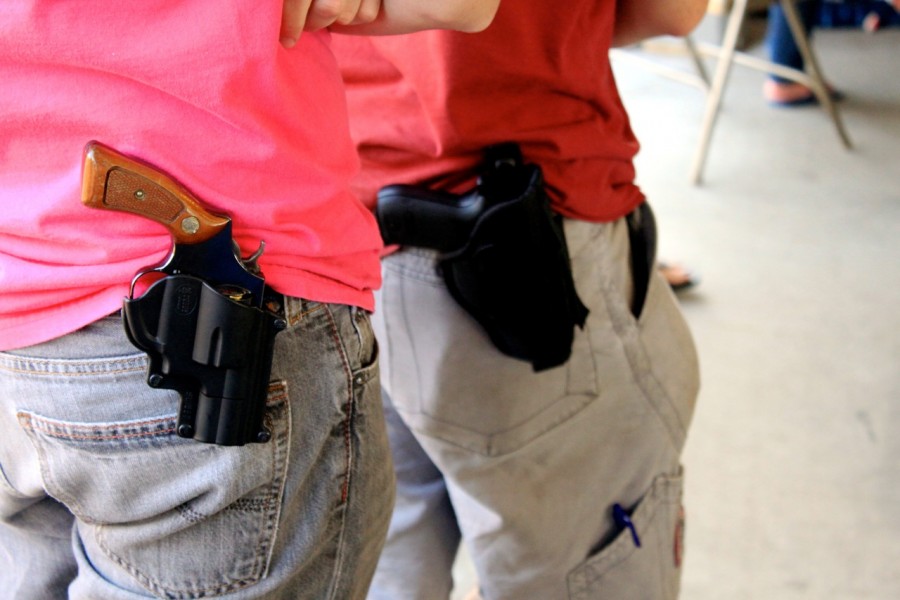Teachers packing heat
The controversies of armed educators
June 22, 2015
In the rash of recent school shootings, many concerns have been brought up concerning defense at school. From the February 29, 2000 shooting in Flint, Michigan, to the December 14, 2012 shooting at Sandy Hook Elementary School, there have been a wide variety of shootings at schools and a distinct increase in the new millennium. Now, as an attempt to increase safety in schools, an unknown amount of teachers across the country have received training in firearm safety and use, and projections show many more are to come. In an ideal world, this might make sense, but when you get down to brass tax and bare knuckles, more guns does not mean less gun violence.
When we think of school shootings, we generally think of students who are upset with others, with the system, or with themselves. The conclusion that teachers who can readily defend against confused, misunderstood, and armed students with violent intent would be a vital and important addition to schools seems reasonable. However, the critical and largely ignored question is should we exclusively prepare for armed students and random intruders and does having armed teachers just open the way for more violent encounters in our schools? Does this bias towards the archetypal school shooter justify putting more guns in schools? If nothing else, is there a greater issue that is being ignored here?
The aforementioned shootings illustrate perfectly why this bias toward students and anonymous intruders as shooters is a dangerous practice. The first shooting in the new millennium occurred on February 29, 2000 by Dedrick Owens, a student in Flint, Michigan. After being picked on by a fellow student, Kayla Rolland, Owens brought his uncle’s handgun to school, concealed in his backpack, and shot and killed Rolland during class. What is most significant about this account, is the fact that just moments after killing Rolland, Owens was brought into the principal’s office, and without skipping a beat, picked up crayons and paper, and began drawing on the desk he was asked to wait at.
Owens, a 6-year-old student at Buell Elementary School, was not even old enough yet to comprehend the gravitas of what he had done. When we think of school shootings, we don’t imagine a 6-year-old wielding the weapon, this is true, but it is important to take situations like these into consideration before relying on armed teachers with defense. Had a teacher been in the room with a weapon, what could they have done? Killed a second 6-year-old? Could they have threatened him with the weapon that they were authorized to use in a shooting scenario? It feels extreme to even consider such an idea, and even though cases like these are isolated, it still serves as a valid example. Many shooters are in their pre-teen years and early teens. When really evaluating the decision to arm teachers, you have to stop and think about teachers aiming and firing at a six year old, or a twelve year old, or even a fourteen year old, and you have to ask what that accomplishes.
Many shooters aim to kill only one person or even do so in the heat of the moment with no premeditation, and armed teachers would not help in any of these cases, or the dozens of cases where shooters haven’t even gotten far enough to kill someone. It’s just one more way for someone to get hurt.
In cases like those of the relatively recent shooting in Newtown, Connecticut, we see an unstable adult behind the barrel. With something like that in consideration, it begs the question: How long until an unstable teacher, who is licensed to carry at school, does the same thing? The odds of something like this are not low. The assumption that students and young adults are the only ones who can become unstable and decide to commit a school shooting is a fatal one. With more and more teachers receiving firearm training and toting their gun into school, it is only a matter of time before one of them snaps, reaches an emotionally unstable period on their life, or reaches some level of psychotic thinking, and opens fire with their very legally operated weapon.
The argument that a student has better access to guns with teachers bringing them to school, and that teachers like one in the viral internet article who shot herself in the foot increase the likelihood of dangerous accidents, is one that is only worth mentioning in brief, because there need be no discussion as to how evident this case is in those scenarios. They make a blatantly obvious case against arming teachers.
On September 10 of this year, a law similar to those in states like Utah was passed in our own state. The law provides the general public more relaxed carrying laws and regulations along with protections for those with licenses to carry. In addition, it drops the carrying age from 21 to 19 and allows anyone who owns a gun to carry it openly or concealed in public places. It includes a law aimed specifically toward school safety, allowing specially trained school employees to carry a weapon both concealed and openly. The responsibility of teachers and school boards to regulate gun safety training and standards is far too large and ambiguous for this law to work in the way people would hope it ideally would. There is too much room for human error for this law to ever be a safe one.
There is only one conclusion to come to when mulling over all the sides to this story. More guns in schools will never equal less school shootings. Let’s focus on making a nurturing and more adequately defended academic environment before we focus on making a more heavily armed one.
